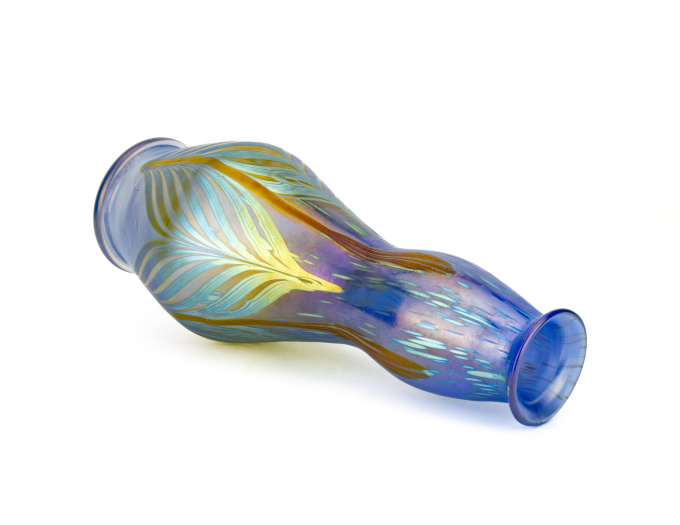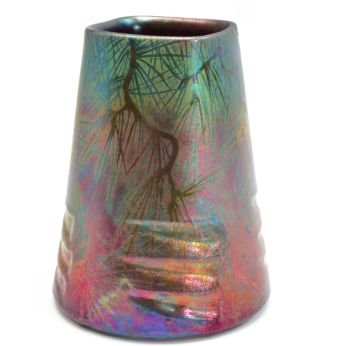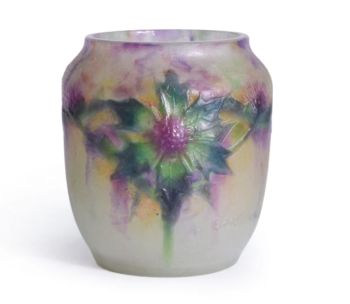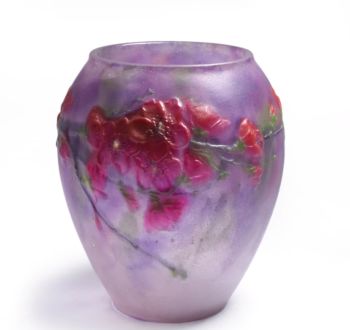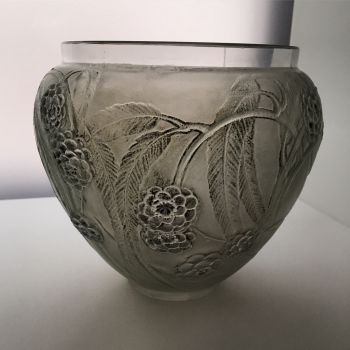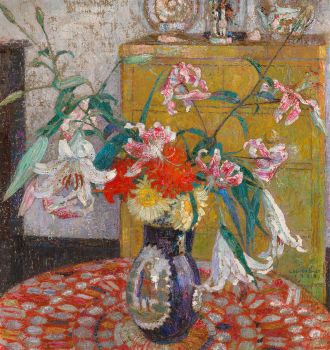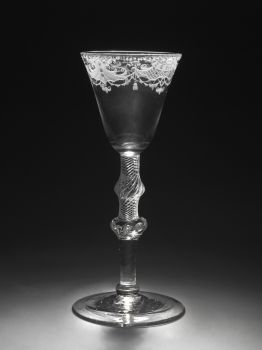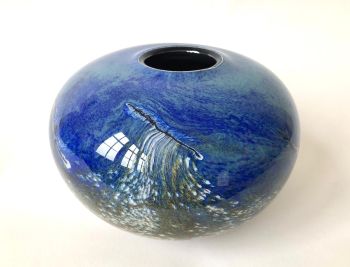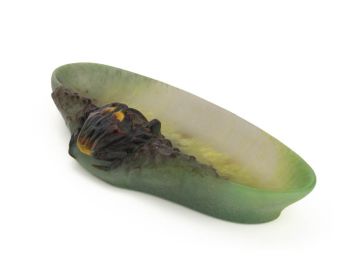Johann Loetz Witwe – Phänomen Genre vaas in blauw opaal – 1902 1902 - 1903
Johann Loetz (Lötz) Witwe Klostermühle
Vidrio
24 cm, ø 9 cm
ConditionMint
Precio a consultar
Antiques Emporium
- Sobre la obra de arteDeze spectaculaire Johann Loetz Witwe Jugendstil vaas behoort tot de iconische Phänomen Genre reeks, een serie waarin de befaamde glasproducent Johann Loetz Witwe zijn meest vernieuwende en artistieke technieken heeft toegepast. Deze specifieke vaas, die te dateren is rond 1902-1903, weerspiegelt de artistieke en technische innovaties die kenmerkend zijn voor de Weense Secession en Jugendstil beweging, waarin de combinatie van kleur, vorm, en techniek samensmelt tot een meesterwerk van glasblaaskunst.
De vaas is vervaardigd uit een opaalblauwe glasmassa die naar de bovenkant toe steeds transparanter wordt, wat een subtiele en vloeiende overgang in kleur creëert. Deze kleurgradatie benadrukt het vakmanschap en artistieke inzicht dat Loetz bezat, en is typerend voor de experimentele stijl van de Phänomen Genre serie. De buik van de vaas is rijkelijk versierd met iriserende verticale banen in een fraai veermotief, dat licht vangt en weerkaatst in een schitterend spectrum van kleuren. Dit iriserende effect, dat sterk doet denken aan de natuurvormen en bewegingen waar Jugendstil om bekend staat, benadrukt het dynamische karakter van de vaas.
Wat deze vaas uniek maakt, is de toevoeging van vier verticale, roodbruine 'tadpoles' die langs de vaas zijn aangebracht. Deze vormen worden omlijst door zilverkleurige, iriserende strepen die het geheel een extra diepte en contrast geven. De gedetailleerde plaatsing en afwerking van deze decoratieve elementen getuigen van de uiterst precieze technieken en artistieke visie die Loetz en zijn ontwerpers toepasten in deze periode.
Het specifieke Phänomen Genre type van deze uitvoering is helaas niet bekend, omdat een groot deel van het Loetz archief uit de periode 1901-1903 verloren is gegaan. Desondanks kan, op basis van vorm, kleurgebruik, en de zeldzame signatuur op deze vaas, met zekerheid worden vastgesteld dat dit stuk een origineel Loetz-ontwerp is uit de periode 1902-1903. Vergelijkbare uitvoeringen uit dezelfde periode bevestigen dat dit stuk niet alleen esthetisch indrukwekkend is, maar ook een representatief voorbeeld vormt van de innovatieve stijl en technische virtuositeit die Loetz in het begin van de 20e eeuw ontwikkelde.
Literatuur:
Sammlung Karl H. Bröhan – Berlin – Kunst der Jahrhundetwende und der zwanziger Jahre. Blz. 195 - Sobre el artista
La cristalería Loetz existió en Klostermuhle, Austria, durante poco más de cien años, a partir de 1840. Pero su apogeo fue durante la vida de Max Ritter Von Spaun, nieto del Johann Loetz original que había fundado la empresa.
Von Spaun se hizo cargo de la empresa en 1879 y la dirigió hasta 1908, un año antes de su muerte. Fue asistido por Eduard Prochaska, su especialista técnico, y juntos inventaron, diseñaron y produjeron toda una serie de maravillosos nuevos tipos de vidrio, obteniendo varias patentes y ganando premios en todas las principales exposiciones mundiales durante la década de 1890 y los primeros años de el nuevo siglo.
La empresa Loetz se encontraba entre los líderes en diseño Art Nouveau y especialmente en vidrio artístico iridiscente. El vidrio "Papillon", como el jarrón de la izquierda, a veces se conoce hoy como vidrio "mancha de aceite". Otro colorante favorito de Loetz fue el vidrio irridizado con senderos tirados llamado vidrio "Fenómeno".
Había jarrones irridizados con cintas de colores metálicos que serpenteaban sobre la superficie, y muchos diseños espectaculares con estelas aplicadas de hermosos colores, o simplemente sacadas del cuerpo del vidrio para formar asas o decoración.
Alrededor de 1900, la compañía comenzó a colaborar con diseñadores externos, y algunos grandes artistas diseñaron piezas para Lotz, en particular Joseph Hofmann, Koloman Moser, Maria Kirchner y Hofstatter.
En 1908 Loetz fue adquirido por el hijo de Max Von Spaun, también llamado Max, y aunque luchó financieramente (pasando por la quiebra en 1911 y nuevamente en 1931) hubo varios grandes diseñadores cuyo trabajo fue producido por Loetz durante esos años y a través del arte. período de deco. Estos incluyeron a Adolf Beckert y Michael Powolny.
¿Está interesado en comprar esta obra de arte?
Artwork details
Related artworks
Johann Loetz (Lötz) Witwe Klostermühle
Johann Loetz Witwe – Ausfuehrung 146 Titania vase – 19121910 - 1919
Preis auf AnfrageAntiques Emporium
Johann Loetz (Lötz) Witwe Klostermühle
Johann Loetz Witwe – Jugendstil Cobalt Papillon vaas1900 - 1910
Preis auf AnfrageAntiques Emporium
Johann Loetz (Lötz) Witwe Klostermühle
Johann Loetz Witwe - Phänomen Genre 7773 – Orange1900 - 1910
Preis auf AnfrageAntiques Emporium
1 - 4 / 7Unbekannter Künstler
François-Théodore Legras – Tall “Fleurs de Pommier” apple blossoms vase1900 - 1909
Preis auf AnfrageAntiques Emporium
Johann Loetz (Lötz) Witwe Klostermühle
Johann Loetz Witwe – Jugendstil Cobalt Papillon vaas1900 - 1910
Preis auf AnfrageAntiques Emporium
1 - 4 / 24Unbekannter Künstler
Ein seltenes Filigrana, ein Retortoli-Becher1550 - 1600
Preis auf AnfragePeter Korf de Gidts - Antiquairs
Unbekannter Künstler
François-Théodore Legras – Tall “Fleurs de Pommier” apple blossoms vase1900 - 1909
Preis auf AnfrageAntiques Emporium
Johann Loetz (Lötz) Witwe Klostermühle
Johann Loetz Witwe - Phänomen Genre 7773 – Orange1900 - 1910
Preis auf AnfrageAntiques Emporium
1 - 4 / 24Unbekannter Künstler
A Japanese bronze Hu flower vase, Edo / Meiji, 19th century19th century
Preis auf AnfrageMenken Works of Art
Jan Voerman sr
Still Life with flowers in a Chinese figurine1850 - 1900
Preis auf AnfrageKunsthandel Pygmalion
1 - 4 / 24Unbekannter Künstler
Salver oder Tazza mit Orangenglas, Gelee und Puddinggläsern.1750 - 1755
Preis auf AnfragePeter Korf de Gidts - Antiquairs
Rene Rietmeyer
"Firenze and Murano September 2007"2007
Preis auf AnfrageEuropean Cultural Centre Collection
1 - 4 / 24Amalric Walter
Amalric Walter & Henri Bergé – Crabe plumier1920 - 1929
Preis auf AnfrageAntiques Emporium
Johann Loetz (Lötz) Witwe Klostermühle
Johann Loetz Witwe – Ausfuehrung 146 Titania vase – 19121910 - 1919
Preis auf AnfrageAntiques Emporium
Johann Loetz (Lötz) Witwe Klostermühle
Johann Loetz Witwe – Jugendstil Cobalt Papillon vaas1900 - 1910
Preis auf AnfrageAntiques Emporium
Demetre Chiparus
Demetre H. Chiparus – Bronze Art Deco statue “Rapture” – Édition Etling, Paris1920 - 1929
Preis auf AnfrageAntiques Emporium
Unbekannter Künstler
François-Théodore Legras – Tall “Fleurs de Pommier” apple blossoms vase1900 - 1909
Preis auf AnfrageAntiques Emporium
Frères Daum
Daum Nancy – “Paysage Soleil Couchant” vase with two applied handles1900 - 1910
Preis auf AnfrageAntiques Emporium
Johann Loetz (Lötz) Witwe Klostermühle
Johann Loetz Witwe - Phänomen Genre 7773 – Orange1900 - 1910
Preis auf AnfrageAntiques Emporium
1 - 4 / 12








